Before You Begin
Today your lab TA will assign you to a new partner. If you haven’t read the Collaboration Guide yet, go check it out to see what’s going on with all this partnership business.
Getting Started
Make sure you’re familiar with conditionals and loops from the Java Crash Course optional assignment before beginning this lab!
For this lab, you should use a simple text editor, such as TextEdit, Sublime, Atom, etc. If you’ve been working ahead, don’t start using IntelliJ just yet.
At the beginning of every lab, we’ll ask that you first get the latest starter code from the skeleton. Run the following command in your terminal from your su19-*** Git repository directory.
The $ below just signifies that we are running this command in our terminal. Don’t actually copy and paste the $ as part of the command.
$ git pull skeleton master
This command asks git to pull our code from the remote repository containing the desired code, which we added yesterday and we called it skeleton. Master indicates that we are accessing the master branch of that remote repository.
Learning Goals
This lab will focus on Java primitives and objects. Our goals for this lab will be as follows.
- Learn the different Java primitives and when to use them.
- Learn how to define classes and use reference-typed variables.
- Learn how to work with box-and-pointer diagrams to identify common usage errors.
Primitives
As you may have noticed, when initializing a variable in Java you must put the type next to it.
int number = 10;
The above line tells Java that the variable number is an integer that holds the value 10. Types represent things such as integers and decimals and are fundamental to the operation of a language. In Java, there are a predefined set of primitive types.
-
boolean : a
booleanrepresents the two possible values oftrueandfalse -
byte : a
byterepresents an 8-bit signed integer. -
short : a
shortrepresents a 16-bit signed integer. -
int : an
intrepresents a 32-bit signed integer. This is the most commonly used integer type and can hold values between -2,147,483,648 to 2,147,483,647 inclusive. -
long : a
longrepresents a 64-bit signed integer. Sometimes when we need to express large integral numbers we will use this as it ranges from -9,223,372,036,854,775,808 to 9,223,372,036,854,775,807. -
float : a
floatrepresents a 32-bit single precision floating point number. Floating point numbers can approximate a range real numbers including integers, decimals, and special values like infinity. Floating point numbers can only represent a finite number of the infinitely many numbers in existence. Anything that cannot be represented is encoded as “NaN”, which stands for “Not a Number”. -
double : a
doublerepresents a 64-bit double precision floating point number. Most of our decimal numbers will use this type as it provides greater precision. -
char : a
charrepresents an ascii letter (like the English alphabet).
These words are reserved in Java. That is we cannot use int and double in any other context besides declaring a variable of that type. Note that all primitives begin with a lowercase letter.
Declaring a primitive is very simple. For example, if we wanted to declare a double, we can write the following.
double pi = 3.14;
Certain primitives require an extra letter after the initial value. For example, to declare a long or a float, we write the following.
long num = 9223372036854775807L;
float num2 = 42.0f;
Finally, we can declare a char using a single-quoted literal. For example, if we want to initialize variable a to the letter “a”, we would write the following.
char a = 'a';
We need not always initialize the value of a primitive. Sometimes it is useful to just a declare a variable and allow later blocks of code to determine its value. We do so by writing the following.
char a;
double d;
Objects
Java is an object-oriented language. This means that everything we want to represent in Java is defined in terms of Objects.
Objects are bundles of code that define the state and behavior of the construct we wish to represent. Suppose we wish to represent a potato. A potato’s state can be described by its variety and age, and it also has behaviors such as grow and flower.
Now suppose Jackson and Matt both have potatoes; Jackson has a Yukon Gold and Matt has a Red Pontiac. Even though Jackson and Matt have different varieties of potatoes, they are both still potatoes. They each have an age, color and variety. Critically, we can describe an entire group of Potatoes with a set of common descriptors.
In Java we define an Object via its Class. Jackson’s Yukon Gold and Matt’s Red Pontiac would then be called instances of the Potato class. Let us see how we can implement a Potato class in Java.
Example
For this section, we will be using Potato code found below. This can be found in lab02/Potato.java.
public class Potato {
/* An instance variable representing the potato's species. */
private String variety;
/* An instance variable representing the potato's age. */
private int age;
/** A constructor that returns a very young russet burbank potato. */
public Potato() {
this.variety = "Russet Burbank";
this.age = 0;
}
/** A constructor that allows you to specify its variety and age. */
public Potato(String variety, int age) {
this.variety = variety;
this.age = age;
}
/** A getter method that returns the potato's type. */
public String getVariety() {
return this.variety;
}
/** A getter method that returns the potato's age. */
public int getAge() {
return this.age;
}
/** A setter method that sets the potato's age to AGE. */
public void setAge(int age) {
this.age = age;
}
/** A method that grows the potato. Note it increases its age by 1. */
public void grow() {
System.out.println("Photosynthesis!");
this.age = this.age + 1;
}
/** Did you know potatoes can flower? No? Neither did I... */
public void flower() {
System.out.println("I am now a beautiful potato");
}
}
We will also be looking at lab02/Potato1.java later on!
Defining a Class
Let’s see how to define our Potato class. To define a Java Class, create a new .java file and encompass the class’s code with the following header
class Potato {
/** Potato code goes here! */
}
There are two things to keep in mind when writing Java classes.
-
Java requires the class name to be the same as the file name. This is why the
Potatoclass is written inPotato.java. -
By convention, the name of a class always begin with a capital letter and is generally named using camel case (ex: ThisIsCamelCase)
Constructors
Now to initialize a Potato object, we must call its constructor. The constructor is a special method that initializes all the variables associated with the class’s instance. Unlike other methods, there is no return type in the constructor’s signature, and it must have the same name as the class itself.
It’s possible to define a constructor that takes in no arguments.
public Potato() {
this.variety = "Russet Burbank";
this.age = 0;
}
Here the constructor returns a baby Russet potato because, as we all know, provided no guidance, the potato obviously becomes a baby russet potato.
We can also specify arguments in our constructor.
public Potato(String variety, int age) {
this.variety = variety;
this.age = age;
}
This constructor returns a potato where we can define its variety and age. Now we can construct potatoes such as Jackson’s 3 year old Yukon Gold potato.
We will discuss how to declare objects in more detail during the Boxes and Pointer Diagrams section.
Caveat: if no constructors are defined in the object file, then the Java compiler will provide a default constructor that accepts no argument. However, if a constructor is defined, then the compiler will not provide a default constructor. Read more about it here.
Instance Variables
Instance variables allow us to represent the state of an object and can be both primitives and objects. The “has a” test is an easy way to see if something should be an instance variable of an object. For example, a potato has an age and variety. Thus, within our Potato class, we see that there are two instance variables: variety and age.
/* An instance variable representing the potato's species. */
private String variety;
/* An instance variable representing the potato's age. */
private int age;
As with any variables we must declare what type it is. The String keyword tells us variety is a String object and int tells us the age is an integer primitive.
Instance variables have default values that correspond to the type of the variable. If instance variables are not initialized in the constructor or elsewhere with a value, they will initially contain the default. These defaults will correspond to a zero value. 0 for int, float, double, etc. false for boolean, and null for Object types.
We can (usually) access the age and variety of the Potato via dot notation. This is similar to Python’s dot notation, which you may have encountered in CS 61A.
Potato jacksonsPotato = new Potato("Yukon Gold", 3); // Jackson's potato!
jacksonsPotato.variety; // returns the variety of Jackson's potato
jacksonsPotato.age; // returns the age
Notice that we had to first instantiate a new potato object before we could access variety or age. The order of the variables that we pass into the new Potato call must match the order of the parameters of the constructor. Remember that instance variables are particular to the object. Thus we need to create an object first in order to have age and variety.
When writing object code within its class, we can also employ the this keyword. Its usage is similar to that of self in Python.
this.variety; // returns the current instance's variety
this.age; // returns the current instance's age
One notable difference, however, is that this cannot be reassigned whereas self in Python can be reassigned.
Note that we can’t use this to refer to jacksonsPotato as we’re not talking about the current (this) potato. Instead, we’re trying to refer specifically to jacksonsPotato.
Now we say “sort of” because we also have a private keyword placed in front of the variety and age declaration. This means we cannot access the age and variety via dot notation outside of Potato.java. We will see more about why we may want to do this in the Getter and Setter Method section later on.
Finally, it’s important to stress that even though all instances of Potato will have the variables variety and age, their values will be specific to each instance - hence the name instance variable.
Instance Methods
To facilitate behavior, we can define instance methods. For example, Potato has defined in it the grow() method.
/** A method that grows the potato. Note it increases its age by 1. */
public void grow() {
System.out.println("Photosynthesis!");
this.age = this.age + 1;
}
Like instance variables, we can access instance methods using dot notation as well.
jacksonsPotato.grow(); // Jackson's potato grows!
We also have a few special instance methods prefixed by the words “get” and “set”. These are aptly named getters and setters, which we’ll learn more about them below!
Getter and Setter Methods
As we have seen, the private keyword limits our ability to access instance variables directly. This is called an access modifier and we will be discussing them in more detail later on in the course.
For now, just know that in general it is good practice to make instance variables private. A consequence of making our instance variables private is that we must now define instance methods to access them.
This is where we introduce getter and setter methods. Within Potato we have these methods.
/** A getter method that returns the potato's type. */
public String getVariety() {
return this.variety;
}
/** A getter method that returns the potato's age. */
public int getAge() {
return this.age;
}
The above two blocks are called getter methods since they get the value of their respective instance variables for programs outside of Potato.java. Of course, due to advancements in genetic modification technology, it is also possible to set the age of our potato.
/** A setter method that sets the potato's age to AGE. */
public void setAge(int age) {
this.age = age;
}
This is called a setter method as it allows us to set the value of an instance variable.
Interestingly enough, we don’t have a setter method for the variety instance variable. This is because until we develop the technology to support spud-transmutation (#PotatoDreams), Jackson’s Yukon Gold potato will forever remain a Yukon Gold potato.
Of course, this is important in an application sense because now external programs cannot maliciously spoof the identity of a potato. Take a look at Potato1.java
/* An instance variable representing the potato's species. */
String variety;
/* An instance variable representing the potato's age. */
int age;
The variety and age are not private meaning we can write a program to change the identity of Jackson’s potato.
/* jacksonsPotato is an instance with variety = "Yukon Gold" */
jacksonsPotato.variety = "Red Pontiac"; // A POTATO IMPOSTER!
The practice of using getters and setters is called information hiding and it prevents external programs from unintentionally (or intentionally!) changing the value of our instance variables.
In an exercise below, we will be considering a bank account. Without a doubt, we will want the balance of our bank account to be private, so that other programs cannot simply set account.balance = 0;.
Box and Pointer Diagrams
For another explanation, you may read Section 2.1 from the CS 61B textbook, starting from the section titled “The Mystery of the Walrus” and stopping just before “The Law of the Broken Futon”.
Throughout this class it will be extraordinarily helpful to draw pictures of the variables in our program to help us with debugging by visualizing the state and changes of objects throughout the code. The diagrams we’ll teach you to use in this class are often referred to as box and pointer diagrams, which are similar to the Environment Diagrams you saw in CS 61A.
Let’s start off with something simple. When we declare a primitive, we draw a box for it, and label the box with the type of primitive, and the name of the variable. Here, primitives will be in red boxes. For example,
int x;

When we assign a value to the primitive, we fill in the box with the value of the primitive.
x = 3;
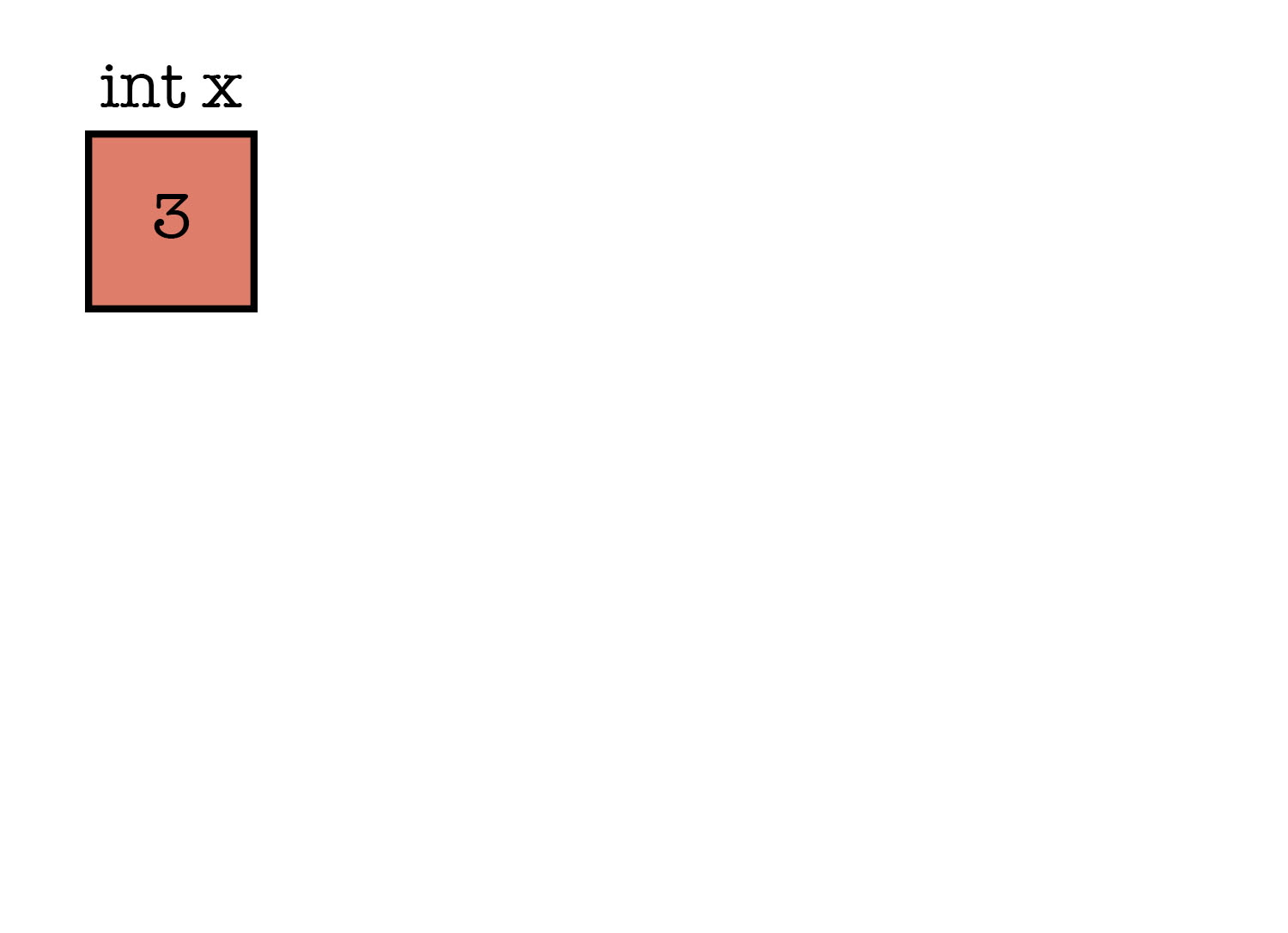
Variables can also refer to objects. For example, it can refer to a Potato instance. We can declare a Potato object the same way as we declare an int.
Potato p;
This variable is called a reference, because it will refer to an object. When we first declare the reference but don’t assign an object to it like in the code above, we say the reference contains nothing, or null. This also occurs when an instance variable is not assigned a value in the constructor. Here’s how we draw it:
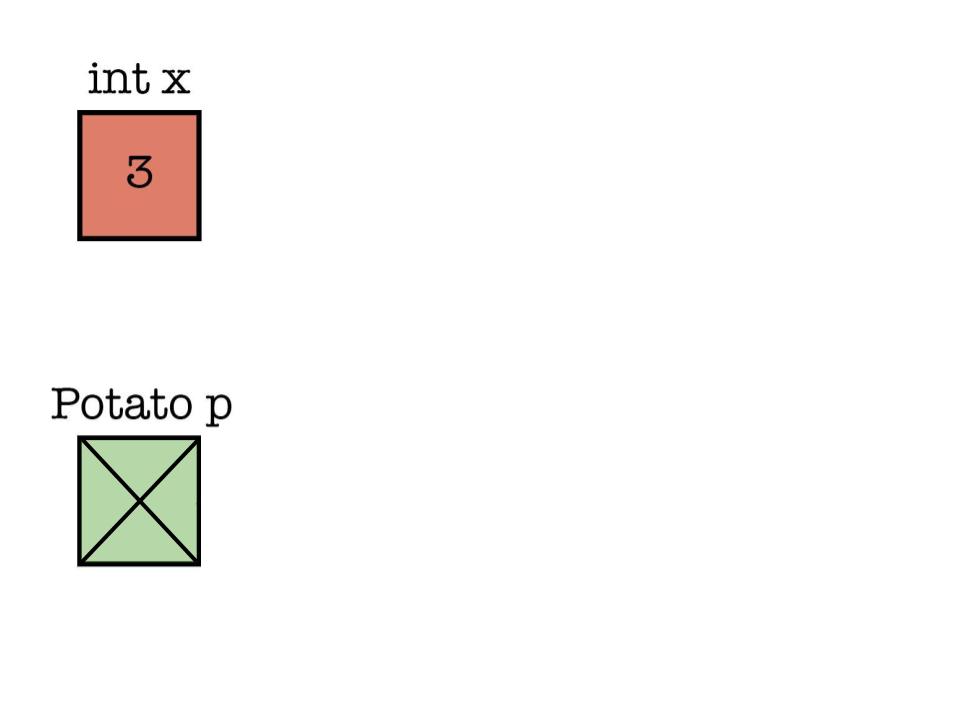
Here we’re drawing references in green to emphasize that they are different from primitives.
Now let’s assign a reference to the Potato object by calling its constructor. This instantiates, or creates, a new instance of the Potato class. Instantiating an object via its constructor always requires the new keyword.
p = new Potato();

Here an object is drawn in blue, to emphasize that it is different from a primitive and a reference. We can now store primitives within the object as instance variables!
One critical thing about the object: unlike the primitive integer, 3, drawn inside the box for x, the Potato object is not drawn inside the variable p. Instead p simply contains an arrow that points to the Potato object. This is why p is called a reference or pointer because it just refers to the object but does not contain it. The true value of the variable p is a pointer to a Potato object rather than the Potato object itself. This is a very, very important distinction!
Of course, when we call the no argument constructor, it will initialize the variety to "Russet Burbank" and the age to 0. Our diagram looks like the following.

Is this what you expected?
Remember that a String in Java is an object, not a primitive. Objects are not drawn inside other objects, so when we initialize variety, we make sure the reference points outside the object.
Discussion: Intuition for Drawing Objects
Discuss with your partner to see if you can come up with intuition as to why these diagrams are drawn the way they are. Why does it make sense that objects are not stored inside variables, but are only referred to them? Why does it make sense that objects are not drawn inside other objects? Why isn’t the blue object box labeled with the name of the variable? There aren’t necessarily correct answers to these question, so just see if you can come up with explanations that make sense to you.
Worksheet: 1. Drawing a char Variable
If you don’t have a worksheet, ask your TA for one. If you’re working from home, come to lab to get it!
Complete this exercise on your worksheet.
Worksheet: 2. Counter
Complete this exercise on your worksheet.
Stack and Heap
When we create Objects, the Java Virtual Machine allocates space on the heap. The heap is where all Objects and arrays live. However, method calls and local parameters are stored on the stack. Each time a method is called, the JVM allocates a stack frame, which stores the parameters and local variables for that method.
At times, we may only care about the heap and the state of the Objects that we create. Other times, it will be useful to keep track of the stack frames as well.
Let’s consider the following code:
public static void main(String[] args) {
Potato p = new Potato();
int newAge = 20
p.setAge(newAge);
}
When the setAge() method is called, the stack and heap looks like below. For now, don’t worry about what a String[] is, we’ll cover that in a later lab.
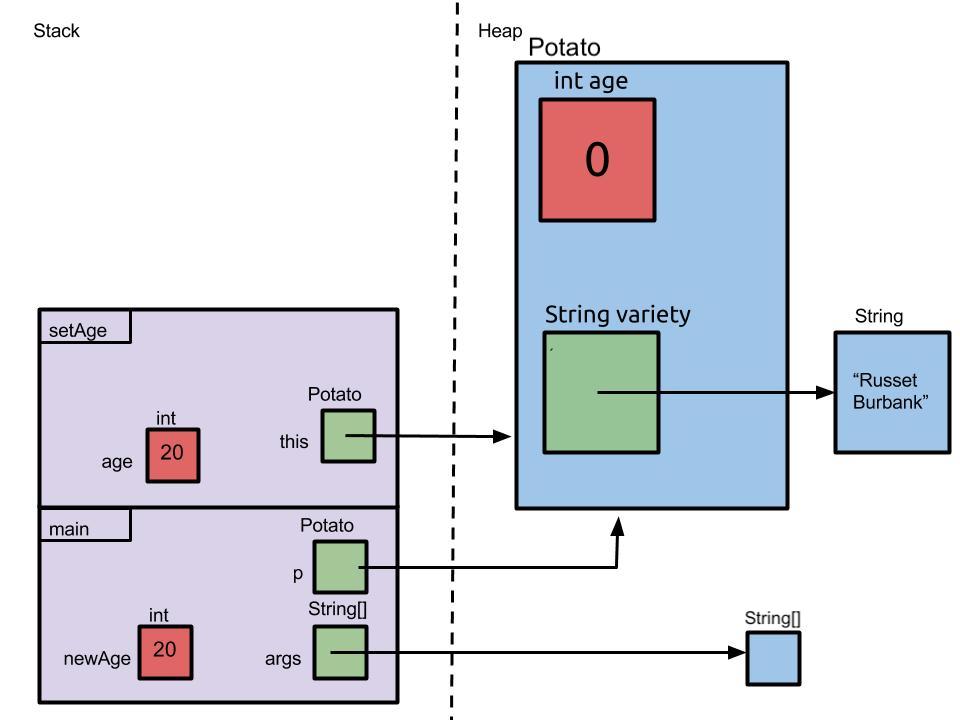
The method that is currently executing (at any given point in time) lies on the top of the stack. All other stack frames are waiting for the top frame to return and be popped off the stack so they can resume execution. When a stack frame is popped, all of its local variables are lost.
One thing that you may notice is that Java is pass-by-value. Methods are passed in copies of the actual parameters. The original parameters cannot be changed by the method. The copies lie in the stack frame.
Consider the following code and the stack and heap diagram, right before tryToIncrement returns.
public static void tryToIncrement(int x) {
x += 1;
}
public static void main(String[] args) {
int x = 10;
tryToIncrement(x);
}
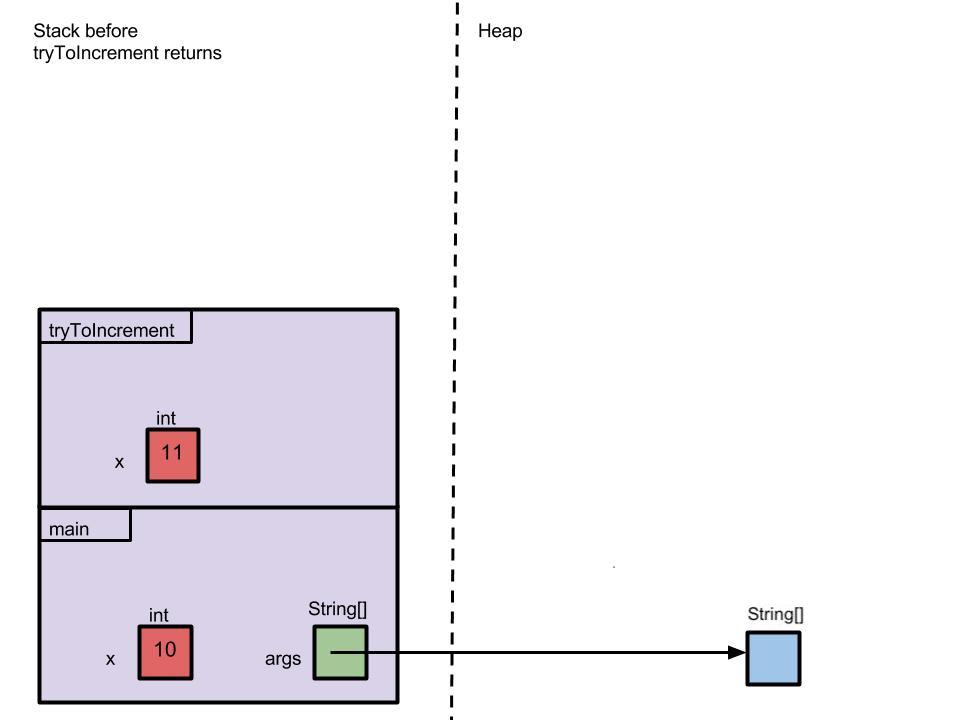
Perhaps here is where it becomes apparent that the value for references is not the Object it references. When we pass in an Object, what is copied is not the Object itself, but the reference to the Object.
public static void refresh(Potato p) {
p.age = 0;
}
public static void main(String[] args) {
Potato potat = new Potato("Red La Soda", 5);
refresh(potat);
}
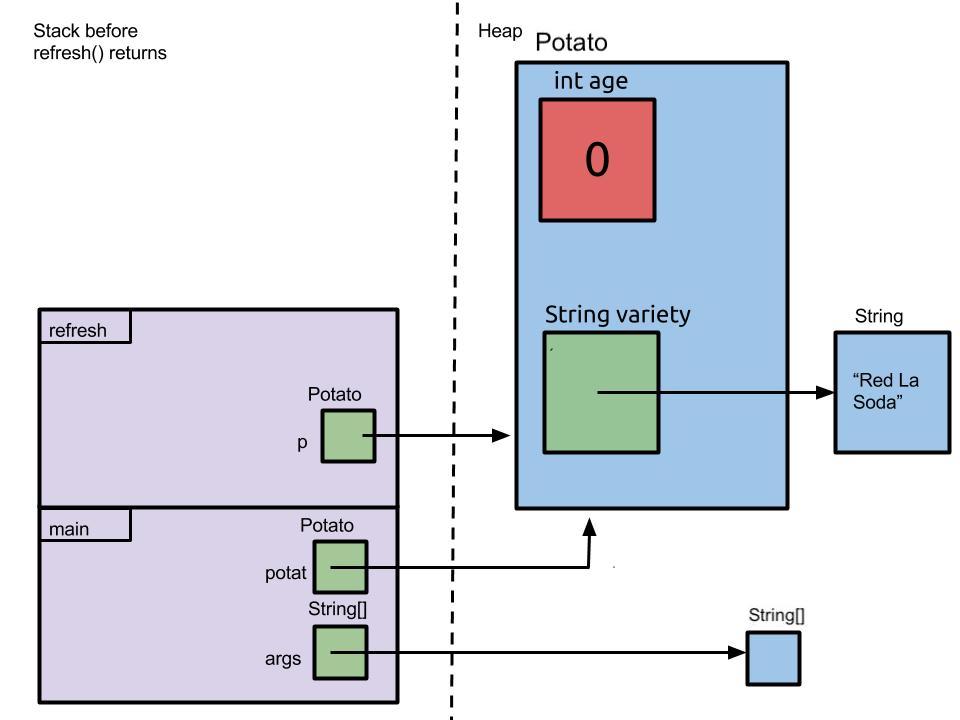
What is copied over into the parameter of the refersh method is not a copy of the Potato object, but a copy of the reference (the arrow) to the Potato Object.
The True Meaning of this
Did you notice that there was something different between when we called the setAge method and when we called the refresh method? Go back to the stack and heap diagrams and discuss with your partner the difference. Look at the code segments and think about why that may be.
setAge is an instance method, which means that it must always be called through dot notation on an Object. Instance methods always have a this variable, which references the Object that the method was called on. In contrast, refresh is a static method (marked with the static keyword). Static methods do not have a this reference in their frame; they belong to the class rather than to an object of the class.
We call being inside a static method during execution being in a static context. You cannot directly reference instance variables from a static context. Instead, you must do so through an object reference (due to the lack of a this reference). Note that static methods can be called from a static context (like in main()) and do not need to be called with an instance associated with them.
Worksheet: 3. Counter Problems
Complete this exercise on your worksheet.
Worksheet: 4. Assignment Statements
Complete this exercise on your worksheet.
Exercise: Account Management
If you haven’t gotten the latest skeleton files, do so now by running the following command from your
su19-**Git repository.$ git pull skeleton master
The next several exercises involve modifications to an Account class, which models a bank account. The file you will be working with is Account.java.
The Account class allows deposits and withdrawals. Instead of warning about a balance that’s too low, however, it merely disallows a withdrawal request for more money than the account contains.
Modifying Withdrawal Behavior
The withdraw method is currently defined as a void method. Modify it to return a boolean: true if the withdrawal succeeds (along with actually performing the withdrawal) and false if it fails.
Merging Accounts
Define a merge method. This method should transfer all of the money from the argument account to the current account. In other words, the argument account balance should be zeroed while the current account’s balance increases by the argument’s old balance. We’ve provided a skeleton of the method in Account.java.
Overdraft Protection
A convenient feature of some bank accounts is overdraft protection: rather than bouncing a check when the balance would go negative, the bank will deduct the necessary funds from a second account. One might imagine such a setup for a student account, provided the student’s parents are willing to cover any overdrafts (!). Another use is to have a checking account that is tied to a savings account where the savings account covers overdrafts on the checking account. In our system, we’ll be keeping things simple with only one type of account so we don’t have to worry about student or savings accounts.
Implement and test overdraft protection for Account objects by completing the following steps.
- Add a
parentAccountinstance variable to theAccountclass; this is the account that will provide the overdraft protection, and it may have overdraft protection of its own. - Add a two-argument constructor. The first argument will be the initial balance as in the existing code. The second argument will be an
Accountreference with which to initialize the instance variable you defined in step 1. - In the one-argument constructor, set the parent account to
null. We’d like to emphasize the fact that there is no parent if the one-argument constructor is used by explicitly settingparentAccounttonull, but notice it is technically unnecessary as any non-initialized objects default tonull. - Modify the
withdrawmethod so that if the requested withdrawal can’t be covered by this account, the difference is withdrawn from the parent account. This may trigger overdraft protection for the parent account, and then its parent, and so on. The number of accounts connected in this way may be unlimited. If the account doesn’t have a parent or if the parent (and its parents and so forth) can’t cover the withdrawal, thewithdrawmethod should merely print an error message as before and not change any account balances.
Here’s an example of the desired behavior, with the Account object christine providing overdraft protection for the Account object matt. Recall this means the parentAccount of matt is christine.
Suppose, in each scenario below, matt has 100 as his balance while christine has 500 as her balance.
mattattempts to withdraw 50mattthen has 50 remaining in his balance, whilechristinestill has 500.mattattempts to withdraw 200mattthen has 0 remaining in his balance, whilechristineneeded to cover 100 formatt, leaving 400 as her balance.mattattempts to withdraw 700- return false without changing either balance as the withdrawal is denied due to insufficient funds.
To test your code, try copy and pasting the
Accountclass into the online Java Visualizer. Make sure to add amainmethod with a few example cases like the ones provided above.Account christine = new Account(500); Account matt = new Account(100, christine); matt.withdraw(50);
Discussion: Merging Revisited
One proposed solution for merging accounts is the following:
public void merge(Account other) {
this.balance = this.balance + other.balance;
other = new Account(0);
}
This doesn’t work. Explain why not.
Exercise: Pursuit Curves
You will now create a class representing a pursuit curve.
Pursuit curves provide a powerful way to render curves on a computer. The traditional method for drawing a path is to analytically define it via some algebraic formula like \(y(t) = t^2\) and trace it point-wise. Consider an alternative where we define two points: the pursuer and the pursued.
Now suppose the pursued point (in black) follows some fixed path \(F(t)\). Then the pursuer (in red) will seek the pursued in the following manner.
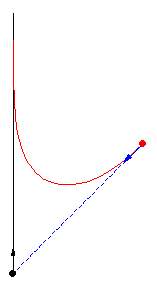
We notice that the pursuer always follows the pursued along its tangent, which gives some serious first order differential equation vibes. Letting the pursuer’s path be given by \(x(t)\), then the closed form solution for its path is given by the following equation.

Of course, we won’t require you to solve a differential equation. In fact, let’s see what your task will be!
Programming Task
Implement a simpler version of pursuit curves in order to create a cool visual by filling out lab02/Path.java. An additional file lab02/PathHarness.java is provided containing code that will render your code in Path.java using Java’s graphics framework.
Path.java will represent the path traveled by the pursuer. You will need to keep track of the following two points:
-
currwill represent where the path currently ends. This will be a Point object. -
nextwill represent where the path (and thus,curr) will travel to next. This will also be a Point object.
Next, you will need to define a constructor that, given an x and y coordinate, sets next to the starting point (x, y). The constructor may look something like this.
public Path(double x, double y) {
// more code goes here!
}
When the Path object is first constructed, curr can be set to a Point instance with any coordinate so long as it is not null. Try playing around with initial curr values to see what you can get!
Finally, you will need to implement the following instance methods.
| method name | return type | functionality |
|---|---|---|
getCurrX() | double | Returns the x-coordinate of curr |
getCurrY() | double | Returns the y-coordinate of curr |
getNextX() | double | Returns the x-coordinate of next |
getNextY() | double | Returns the y-coordinate of next |
getCurrentPoint() | Point | Returns curr |
setCurrentPoint(Point point) | void | Sets curr to point |
iterate(double dx, double dy) | void | Sets curr to next and updates the position of next to be curr with movement defined by dx and dy. |
A note on iterate(double dx, double dy). If you were to implement a pursuit curve in full generality, then this is where you would solve a differential equation. But again, we won’t have you do that. Instead we’re giving you \(dx\) and \(dy\) which will tell you how the path travels on each call to iterate.
To summarize your task:
-
Keep track of
currandnext. -
Implement a constructor taking in a
double xanddouble y. -
Implement the methods listed in the table above.
Here are some tips to keep you on the right track!
-
As
currandnextare bothPointobjects, we’ve provided a class definingPoint. Make sure to read through and understand what each method and constructor does! -
When defining
iterate(double dx, double dy)you may find that yourcurrandnextare not being set to what they are coded to be. Think about object references and try drawing a box-and-pointer diagram.
If you want to learn more about pursuit curves, Wolfram’s MathWorld provides a very interesting read.
static
There’s something that we’ve been kind of waving off up until now: the static keyword. In Java, static fields belong to the class instead of a particular instance. We call these static fields or class variables. During execution, only one instance of a static field exists throughout, no matter how many instances of the class are created. You can think of them as living in their own special space, away from each instance. Static fields can be referenced the same as instance variables from within a instance method. They can also be directly referenced as ClassName.staticVariable, or by the instance reference (although this is not recommended for style). For example, in the Dog class if we wanted to access a static field genus, we could either write:
Dog fido = new Dog();
System.out.println(Dog.genus); // ok
System.out.println(fido.genus); // ok
Recall that methods can also be static. This just means the method does not belong to a specific instance, like instance methods do. We can call them in a similar way, using either the class name or an instance.
Worksheet: 5. Static Methods and Variables
Complete this exercise on your worksheet.
Conclusion
Coding is not easy! Keeping track of what references point to what, modifying code (which you first have to understand), and systematically finding bugs are definitely not skills that develop overnight. Make sure to practice! You can get your partner or another classmate involved and generate variants of the lab exercises to provide extra practice.
The exercises on complicated uses of references are easy to produce and can be verified online using tools such as Java Visualizer or by simply running your code through intelliJ.
The internet is also a great boon for more coding practice. Checkout Reddit’s /r/dailyprogrammer and topcoder’s online exercises. Project Euler also provides a ton of questions with solutions that a potential interviewer might one day ask you!
For coding, practice is crucial so make sure to do so! Finally, if you or anyone you know is struggling, let a TA know and we’ll be more than happy to help.
Deliverables
To quickly recap what you need to do for this lab:
- Read through the lab and learn about Java objects and the Golden Rule of Equals. Make sure you understand how to draw box-and-pointer diagrams.
- Build good collaboration habits as you work through the provided discussion questions and exercises.
- Complete the worksheet and turn it in to your TA by the end of your lab section.
- In
lab02/Account.javaedit the behavior of withdrawal to return a boolean then implement account merging and overdraft protection. - Implement
lab02/Path.javathe keeps track ofcurrPointandnextPointand implements the methodsgetCurrX(),getCurrY(),getNextX(),getNextY()anditerate(dx, dy)
Submission
- Save your java files, and in your terminal, navigate to your
su-**directory using thecdcommand. - Once there,
git add .to stage your files,git commit -m "finished lab 2"to make your commit, andgit pushto upload to GitHub.com. - Go to Gradescope.com and submit to the correct assignment by submitting via GitHub. The autograder will run and tell you your score. Remember, both people in the partnership need to submit to Gradescope to receive credit.
